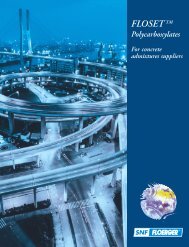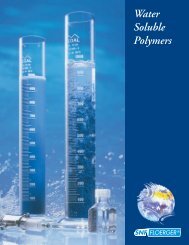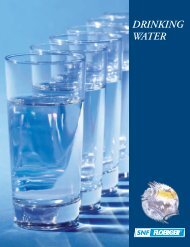SLUDGE DEWATERING - SNF Group
SLUDGE DEWATERING - SNF Group
SLUDGE DEWATERING - SNF Group
You also want an ePaper? Increase the reach of your titles
YUMPU automatically turns print PDFs into web optimized ePapers that Google loves.
R I N G<br />
4.2. Lab tests:<br />
4.2.1. Sampling:<br />
Of the solution to be treated.<br />
A representative sample of the sludge must be taken.<br />
In order to achieve this, the sample will be taken just before the polymer injection point and the<br />
lab tests will be executed rapidly after sampling (the sludge condition may change over time).<br />
An analysis of the Dry Solids content (DS) of the sludge must be made since the polymer dosage<br />
is a function of the DS.<br />
Of the polymer.<br />
It is not necessary to test all the products available (more than 200 for dewatering<br />
applications), a primary screening will do. Select the ionic charge by testing a range of<br />
products with the same molecular weight: FLOPAM AN 900 SH Series for the anionic powders<br />
and FLOPAM FO 4000 SH for the cationic powders.<br />
4.2.2. Laboratory equipment:<br />
In order to analyse the volume of drained water in function of time, the minimum equipment<br />
necessary is as follows:<br />
● 400 ml beakers<br />
● 90 mm diameter buchner funnel.<br />
● 90 mm diameter belt filter cloth<br />
● 250 ml graduated cylinder<br />
● Stopwatch<br />
A repeatable drainage control can be done via a computer-linked scale that weighs the drained<br />
filtrate. This computer recording of the drainage test is recommended since the first 10<br />
seconds of the drainage are the most crucial.<br />
Note:<br />
See the brochure « Preparation of Organic Polymers » to have a list of the necessary equipment<br />
to prepare polymer solutions.<br />
belt filter dewatering<br />
17






